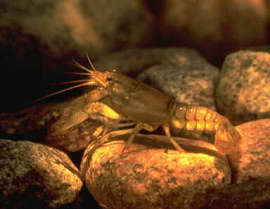Types of river
 Generally speaking, in Britain you can find three main types of river;
Generally speaking, in Britain you can find three main types of river;
- with both upland and lowland sections
- with upland sections only and flowing mainly westerly
- flowing only in lowland, found in the south and east of Britain.
Within these geographical areas, there is a variety of types which are determined by the type of rocks the river is flowing over. Along its route, the water in a river may pass over several different types of substrate (the rock below it); clay, sandstone, chalk, soft or hard limestone. Each kind of rock has an influence on both the water and the species of animals and plants that live there.
For example, the freshwater crayfish, a large crustacean, needs water with plenty of oxygen and a good supply of lime in the water to help build up its thick, outer skeleton; a fast flowing river running over chalk is ideal for this particular animal. A gravel-bottomed stretch of river will have a different group of plants to a stretch with a silted clay bottom.
Read More: Humans Influence on Rivers